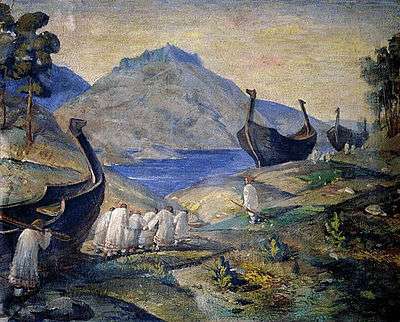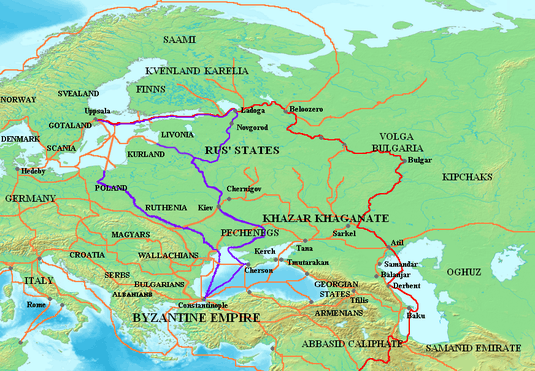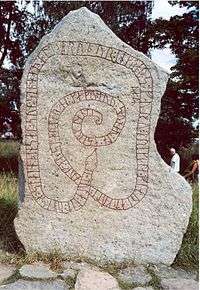Volga trade route
In the Middle Ages, the Volga trade route connected Northern Europe and Northwestern Russia with the Caspian Sea and the Sasanian Empire, via the Volga River.[1][2] The Rus used this route to trade with Muslim countries on the southern shores of the Caspian Sea, sometimes penetrating as far as Baghdad. The powerful Volga Bulgars (cousins of today's Balkan Bulgarians) formed a seminomadic confederation and traded through the Volga river with Viking people of Rus' and Scandinavia (Swedes, Danes, Norwegians) and with the southern Byzantine Empire (Eastern Roman Empire) [3] Furthermore, Volga Bulgaria, with its two cities Bulgar and Suvar east of what is today Moscow, traded with Russians and the fur-selling Ugrians.[4][3] Chess was introduced to Old Russia via the Caspian-Volga trade routes from Persia and Arabic lands.[5]

The route functioned concurrently with the Dnieper trade route, better known as the trade route from the Varangians to the Greeks, and lost its importance in the 11th century.
Establishment
.jpg)
The Volga trade route was established by the Varangians (Vikings) who settled in Northwestern Russia in the early 9th century. About 10 km (6 mi) south of the Volkhov River entry into Lake Ladoga, they established a settlement called Ladoga (Old Norse: Aldeigjuborg).[6] Archaeological evidence suggests Rus trading activities along the Volga trade route as early as the end of the 8th century. The earliest and the richest finds of Arabic coins in Europe were discovered on the territory of present-day Russia, particularly along the Volga, at Timerevo in the district of Yaroslavl. A hoard of coins found at Petergof, near Saint Petersburg, contains twenty coins with graffiti in Arabic, Turkic (probably Khazar) runic, Greek, and Old Norse runic, the latter accounting for more than half of the total. These coins include Sassanid, Arab, and Arabo-Sassanid dirhams, the latest of them dated to 804–805.[7] Having examined major finds of Arabic coins in Eastern Europe, Valentin Yanin conclusively demonstrated that the earliest monetary system of early Russia was based on the early type of dirham minted in Africa.[8] Furthermore, Iranian lusterware was already discovered in the Oka and Upper Volga regions (more precisely, it is spread in Rostov, Yaroslavl, Suzdal, Tver, Moscow and Ryazan).[9]
Functioning
From Aldeigjuborg, the Rus could travel up the Volkhov River to Novgorod, then to Lake Ilmen and further along the Lovat River. Taking their boats around 3 kilometers over a portage, they reached the sources of Volga. The traders brought furs, honey, and slaves through territory held by Finnish and Permian tribes down to the land of the Volga Bulgars. From there, they continued by way of the Volga, to the Khazar Khaganate, whose capital Atil was a busy entrepot on the shore of the Caspian Sea. From Atil, the Rus merchants traveled across the sea to join the caravan routes leading to Baghdad.[6] In 9th and 10th centuries the river was also major trade route between Russians, Khazars and Volga Bulgars.[10][11] Furthérmore the Volga connected merchants from Volga Bulgaria with people from Scandinavia and the southern Byzantine Empire, as well with Russians and Ugrians.

Around 885–886, ibn Khordadbeh wrote about the Rus merchants who brought goods from Northern Europe and Northwestern Russia to Baghdad:
[They] transport beaver hides, the pelts of the black fox and swords from the farthest reaches of the Saqaliba to the Sea of Rum [i.e., the Black Sea]. The ruler of Rum [i.e., the Byzantine Empire] takes a tithe of them. If they wish, they go to the Tnys river [i.e., "Tanais", the Greek name of the Don River], Yitil [i.e., Itil, the ancient name of the Volga], or Tin [variously identified as Don or Seversky Donets], the River of the Saqaliba. They travel to Khamlij, the city of the Khazars whose ruler takes a tithe of them. Then they betake themselves to the Sea of Jurjan [Caspian Sea] and they alight on whichever of its shores they wish. ... Sometimes, they carry their goods from Jurjan by camel to Baghdad. Saqlab slaves translate for them. They claim that they are Christians and pay the jizya.[12]
In ibn Khordadbeh's account, the Rus are described as "a kind of the Saqaliba", a term usually used to refer to Slavs, and anti-Normanist scholars have interpreted this passage as indicative of the Rus being Slavs rather than Scandinavians. In the interpretation of the Normanist scholars, the word Saqaliba was also frequently applied to all fair-haired, ruddy-complexioned population of Central, Eastern, and Northeastern Europe, so ibn Khordadbeh's language is ambiguous here (see Rus' (people) for details of the dispute between Normanists and Antinormanists).[12]
Modern scholars have also clashed over the interpretation of ibn Khordadbeh's report that the Rus used Saqlab interpreters. Anti-Normanists construed this passage as evidence that the Rus and their interpreters shared a common Slavic mother tongue. Slavic, however, was a lingua franca in the Eastern Europe at that time.[12]
The Persian geographer ibn Rustah described the Rus communities living along Volga:
They sail their ships to ravage as-Saqaliba [the surrounding Slavs], and bring back captives whom they sell at Khazaran and Bolghar... They have no estates, villages, or fields; their only business is to trade in sable, squirrel, and other furs, and the money they take in these transactions they stow in their belts. Their clothes are clean and the men decorate themselves with gold armlets. They treat their slaves well, and they wear exquisite clothes since they pursue trade with great energy.[13]
In 921–922, ibn Fadlan was a member of a diplomatic delegation sent from Baghdad to Volga Bulgars, and he left an account of his personal observations about the Rus of the Volga region, who dealt in furs and slaves. Johannes Brøndsted interpreted ibn Fadlan's commentary as indicating that these Rus retained their Scandinavian customs regarding weapons, punishments, ship-burials, and religious sacrifices.[14] Ibn Fadlan's account includes a detailed description of the Rus praying and making sacrifices for success in trade:
On anchoring their vessels, each man goes ashore carrying bread, meat, onions, milk, and nabid [possibly, beer], and these he takes to a large wooden stake with a face like that of a human being, surrounded by smaller figures, and behind them tall poles in the ground. Each man prostrates himself before the large post and recites: 'O Lord, I have come from distant parts with so many girls, so many sable furs (and whatever other commodities he is carrying). I now bring you this offering.' He then presents his gift and continues 'Please send me a merchant who has many dinars and dirhems, and who will trade favourably with me without too much bartering.' Then he retires. If, after this, business does not pick up quickly and go well, he returns to the statue to present further gifts. If results continue slow, he then presents gifts to the minor figures and begs their intercession, saying, 'These are our Lord's wives, daughters, and sons.' Then he pleads before each figure in turn, begging them to intercede for him and humbling himself before them. Often trade picks up, and he says 'My Lord has required my needs, and now it is my duty to repay him.' Whereupon he sacrifices goats or cattle, some of which he distributes as alms. The rest he lays before the statues, large and small, and the heads of the beasts he plants upon the poles. After dark, of course, the dogs come and devour the lot -and the successful trader says, 'My Lord is pleased with me, and has eaten my offerings.'[15]
On the other hand, the Rus came under foreign influence in such matters as dead chief's costume and in the habit of overloading of their women with jewelry:[14]
Each woman carries on her bosom a container made of iron, silver, copper, or gold -its size and substance depending on her man's wealth. Attached to the container is a ring carrying her knife which is also tied to her bosom. Round her neck she wears gold or silver rings; when a man amasses 10,000 dirhems he makes his wife one gold ring; when he has 20,000 he makes two; and so the woman gets a new ring for every 10,000 dirhems her husband acquires, and often a woman has many of these rings. Their finest ornaments are green beads made from clay. They will go to any length to get hold of these; for one dirhem they procure one such bead and they string these into necklaces for their women.[16]
Slavs
Decline
The Volga trade route lost its importance by the 11th century due to the decline of silver output in the Abbasid caliphate, and thus, the trade route from the Varangians to the Greeks, which ran down the Dnieper to the Black Sea and the Byzantine Empire, gained more weight.[17] The Icelandic saga Yngvars saga víðförla describes an expedition of Swedes into the Caspian launched around 1041 from Sweden by Ingvar the Far-Travelled (Ingvar Vittfarne in Norse), who went down the Volga into the land of the Saracens (Serkland). The expedition was unsuccessful, and afterwards, no attempts were made to reopen the route between the Baltic and Caspian seas by the Norsemen.[18]
Notes
- "COMMERCE iii. Parthian and Sasanian periods – Encyclopaedia Iranica". www.iranicaonline.org. Retrieved 2019-08-13.
- Squitieri, Andrea, author. (2018-02-15). Revolutionizing a World : From Small States to Universalism in the Pre-Islamic near East. UCL Press. p. 171. ISBN 9781911576648. OCLC 1050964552.CS1 maint: multiple names: authors list (link)
- "Bulgar | people". Encyclopedia Britannica. Retrieved 2019-08-10.
- Winroth, Anders, author. (2014-01-07). The conversion of Scandinavia : Vikings, merchants, and missionaries in the remaking of Northern Europe. p. 96. ISBN 9780300205534. OCLC 857879342.CS1 maint: multiple names: authors list (link)
- "History of Chess". www.nejca.co.uk. Retrieved 2019-10-13.
- Brøndsted (1965), pp. 64–65
- Noonan (1987-1991), pp. 213–219.
- Денежно-весовые системы русского средневековья: домонгольский период, 1956
- Muqarnas : an annual on the visual culture of the islamic world. Volume 16. Necipoğlu, Gülru. Leiden: E.J. Brill. 1999. p. 102. ISBN 9004114823. OCLC 44157164.CS1 maint: others (link)
- Noonan, Thomas S. (1978). "Suzdalia's eastern trade in the century before the Mongol conquest". Cahiers du Monde Russe. 19 (4): 371–384. doi:10.3406/cmr.1978.1335.
- "Vikings as Traders". History. 2014-06-08. Retrieved 2019-08-10.
- "Rus." Encyclopaedia of Islam
- Brøndsted (1965), p. 268
- Brøndsted (1965), p. 267
- Brøndsted (1965), p. 266
- From ibn Fadlan. Brøndsted (1965), p. 265
- Brøndsted (1965), p. 117
- Logan (1992), p. 202; Brøndsted (1965), p. 117
References
- Brøndsted, Johannes (1965). The Vikings. (transl. by Kalle Skov). Penguin Books.
- Golden, P.B. (2006) "Rus." Encyclopaedia of Islam (Brill Online). Eds.: P. Bearman, Th. Bianquis, C.E. Bosworth, E. van Donzel and W.P. Heinrichs. Brill.
- Logan, Donald F. (1992). The Vikings in History 2nd ed. Routledge. ISBN 0-415-08396-6
- Noonan, Thomas Schaub (1987–1991). "When Did Rus/Rus' Merchants First Visit Khazaria and Baghdad?" Archivum Eurasiae Medii Aevi 7, pp. 213–219.
